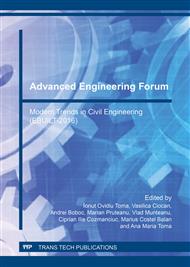p.122
p.129
p.135
p.141
p.151
p.161
p.169
p.175
p.183
Determination of Internal Forces Using Artificial Neural Networks
Abstract:
Design and verification of engineering structures require knowing the numerical values of sectional internal forces as close to reality, considering that the intervention construction works are correlated with these values.Most of the computer programs are working with finite element method, which was designed by engineers and founded by mathematicians. After running the computer program, stresses and deformations maps are generated as results.Considering these results, using artificial neural networks, a computer program has been designed, which is able to determine internal forces of a section, namely axial force, shear force and bending moment.Neural network input parameters consist of color maps resulted from numerical modeling, numerical values of the normal and tangential tensions and dimensions of the structural element.This procedure is particularly useful when using finite element programs that do not have the ability to determine sectional internal forces.
Info:
Periodical:
Pages:
151-157
Citation:
Online since:
March 2017
Price:
Сopyright:
© 2017 Trans Tech Publications Ltd. All Rights Reserved
Share:
Citation:


